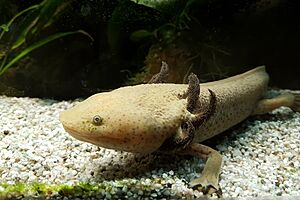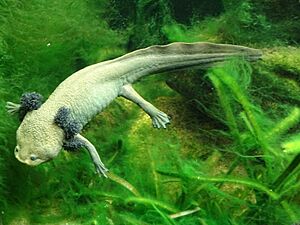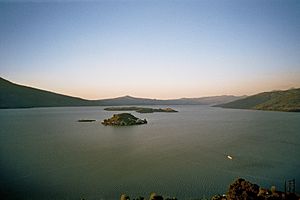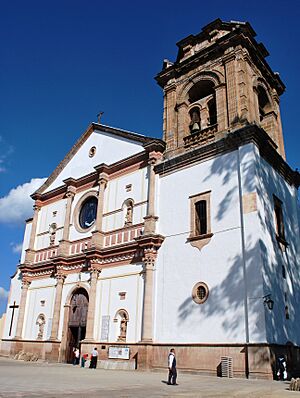Lake Patzcuaro salamander facts for kids
Quick facts for kids Lake Patzcuaro salamander |
|
|---|---|
 |
|
| Conservation status | |
| Scientific classification | |
| Genus: |
Ambystoma
|
| Species: |
dumerilii
|
| Synonyms | |
|
|
The Lake Patzcuaro salamander, also known as the achoque (Ambystoma dumerilii), is a special type of salamander. It is found only in Lake Pátzcuaro, a high-up lake in Michoacán, Mexico. This salamander is unique because it is neotenic. This means it keeps its baby features, like external gills, even when it grows into an adult.
Scientists first described the achoque in 1870. Its name honors a French scientist named Auguste Duméril. For a long time, the Purépecha people have used achoques as food and in their traditional medicines.
Achoques are often compared to axolotls because they look and act alike. Even though they live in different places in the wild, they can have babies together if they are kept in captivity. This salamander is critically endangered, mainly because of pollution, too much fishing, and new species that don't belong in the lake. Scientists believe there are fewer than 100 achoques left in the wild. They might even disappear completely in the next 20 to 30 years. Luckily, there are groups working to protect them. The most famous group is a colony run by the Sisters of the Dominican Order in Mexico. They have the largest known group of these salamanders in the world.
Contents
What is the Lake Patzcuaro Salamander?
The Lake Patzcuaro salamander is a type of mole salamander. It was first described in 1870 by Alfredo Dugès. Over the years, its scientific name has changed a few times. Its current name, Ambystoma dumerilii, was given in 2012.
People call this salamander the Lake Patzcuaro Salamander, Dumeril's salamander, or most commonly, achoque. The word "achoque" comes from the Purépecha language. It means something similar to the word "axolotl," which is used for many water-dwelling salamanders.
How did the Lake Patzcuaro Salamander evolve?
The Lake Patzcuaro salamander developed about 10 to 12 million years ago. This happened when the Trans-Mexican Volcanic Belt formed, splitting the land and separating groups of salamanders. Volcanic activity also separated Lake Pátzcuaro from other lakes. This caused the ancestors of the achoque and axolotl to become isolated in their own environments.
What does the Lake Patzcuaro Salamander look like?

Lake Patzcuaro salamanders are large, cold-blooded creatures. Adult salamanders are usually about 12.2 centimeters (4.8 inches) long from snout to vent. Some can grow much larger, over 35 centimeters (13.8 inches) long! This makes them one of the biggest salamanders in their group. On average, they weigh about 121 grams (0.27 pounds). Females usually weigh more than males.
Their skin can be smooth or bumpy. Their backs range from tan-brown to green, sometimes with dark spots. Their bellies are pale gray. Their toes, snout, and tail often have darker colors. Their gills are usually red. One expert described their color as "dijon mustard" and said they look like "miniature versions of the flying dragon-dog Falkor" from The Neverending Story.
Achoques have flat, wide heads and mouths. A fin runs from behind their head to the end of their tail. They have large, feathery gills that stay with them their whole lives. Their eyes are small and close to their snout. Their bodies are widest at the chest and get narrower towards the tail. Their legs are short and strong, with webbed feet that have four toes. They are the only salamander in their group to keep webbed feet on all four limbs as adults.
Life cycle and reproduction
Achoques mate in winter and early spring. Male salamanders start by arching their tails and swimming around the female. If the female is interested, she follows the male to a breeding spot. There, the male releases small packets of sperm. The female then lays her eggs, which takes about 24 to 72 hours. She attaches individual eggs to plants or rocks.
A female can lay over 1,000 eggs at once! Each egg is about 1.8 millimeters (0.07 inches) wide. Eggs start to develop in the spring during the rainy season. They hatch when the weather gets warmer.
Growth and development
The different stages of an achoque's life are mostly based on how long they are. When they first hatch, they are about 12 millimeters (0.47 inches) long. They are brown and have developing front legs. As they grow, they develop all their limbs and feathery gills.
Achoques become ready to reproduce when they are about 18 to 24 months old. Some can mature as early as 8 to 12 months. Males usually mature faster than females. They can be identified by swelling around their cloaca during breeding season. Achoques can live up to 16 years in captivity.

What is neoteny?
This species is neotenic, which means it keeps its larval (baby) features even as an adult. The most noticeable feature is their large, external gills, which are full of blood vessels. Most other salamanders lose their gills and develop lungs when they become adults. While achoques do have lungs, they mostly breathe through their gills and skin.
Can they change their form?
Wild achoques have not been seen changing their form, but some can do so in captivity. This change, called metamorphosis, is often incomplete and can take up to three years. It might happen if the salamanders are stressed or due to hormones during mating season.
If an achoque undergoes metamorphosis, its lifespan becomes much shorter. They often stop eating and need help to survive. This is because Ambystoma dumerilii lacks the right genes to complete the transformation properly. This can lead to problems with their body shape and often results in death.
Can they create hybrids?
Lake Patzcuaro salamanders, axolotls (Ambystoma mexicanum), and tiger salamanders (Ambystoma tigrinum) all have similar mating behaviors. In labs, scientists have successfully bred these species together. The babies, called hybrids, are often larger than axolotl larvae. As they grow, hybrids look like a mix of achoques and axolotls.
Behavior and diet
Since achoques are rare in the wild, most of what we know about their behavior comes from watching them in captivity. They are mostly active at night, but they will also look for food during the day. They move by "walking" along the bottom of the lake. They use their tail fin to swim when needed. They can control how much air is in their lungs to help them float or sink. If they get scared, they pull their legs close to their body and dive down to hide in plants or under rocks. Like axolotls, achoques can regrow lost limbs. They usually don't make sounds, but they might croak or squeak if taken out of the water.
Before new species were introduced to Lake Pátzcuaro, the achoque was likely a top predator. They might have been hunted by herons or a type of snake, but this has never been seen. Achoques can get parasites like fish lice on their skin and gills, but it's not known if these harm them.
What do they eat?
Ambystoma dumerilii use their gill rakers to create a sucking motion to pull in food. They push water through their mouth and out their gills, trapping prey inside. Young and adult achoques use their sense of smell to find food. They often stand on their front legs and sweep their snouts through the lake bottom to find prey. In captivity, they eat small water bugs, tiny fish, and eggs.
In the wild, achoques mostly eat a type of crayfish called Cambarellus patzcuarensis. Wild achoques often refuse other foods. They sometimes eat plants or algae, but this is usually by accident and doesn't give them much nutrition. Baby achoques eat many small invertebrates, but they have also been seen eating other young salamanders.
How do they interact with new species?
Some invasive plants in Lake Pátzcuaro produce harmful chemicals for the salamanders. Between the 1930s and 1970s, different types of fish like carp and bass were put into Lake Pátzcuaro. These fish eat achoque eggs and babies. Carp also compete with achoques for their main food source, the crayfish.
These new fish also brought new parasites, like Lernaea cyprinacea, which can attach to the achoques' gills. Old World fungi can also harm the salamanders. One fungus, Batrachochytrium dendrobatidis, can infect achoques and cause a serious disease called chytridiomycosis.
Where do they live and what are the threats?

The Lake Patzcuaro salamander lives only in Lake Pátzcuaro, Mexico. This lake is high up in the mountains, about 1,920 meters (6,300 feet) above sea level. It is a freshwater lake with a pH of 8.1 to 9.6. The deepest part of the lake used to be 11 meters (36 feet). The last known wild group of achoques lives at the northern end of Lake Pátzcuaro. They are most often found near the islands of La Pacanda and Tzitzipandácuri.
The exact number of achoques in the wild is not known. However, in 2021, fishermen reported still finding young salamanders in their nets. This means there is still a group reproducing in the wild. In 2018, National Geographic estimated that fewer than 100 individuals might be left. They warned that the species could disappear from the wild by 2040 to 2050. The achoque is listed as critically endangered by the IUCN and is a protected species in Mexico. However, the Mexican government has not yet put in place strong protection plans for the species or the lake.
Why is their home disappearing?
The achoque population has dropped a lot because of habitat destruction and pollution. The city of Pátzcuaro is growing, and waste from the surrounding villages flows into the lake. This includes dirt, fertilizer, sewage, and animal waste. This pollution, along with deforestation, has harmed the water quality and caused the lake to become too rich in nutrients, a process called eutrophication.
Also, between 1982 and 2010, Lake Pátzcuaro lost a quarter of its water volume. Water temperatures have also gone up. This is due to siltation, where dirt and sediment fill the lake, making it shallower. The lake's depth has decreased by about 2.6 meters (8.5 feet). Efforts to clean up the lake in the 1990s and 2000s were not successful.
How do people interact with them?
Historically, fishermen have caught Ambystoma dumerilii since before Christopher Columbus arrived in the Americas. The Purépecha people ate achoques and used them in traditional medicines. This medicine, sometimes called 'Achoque soup', was believed to help with breathing problems, anemia, and to give energy to children. It was also given to new mothers.
Achoques were widely caught until 1989, when their population crashed because the lake's conditions got so bad. Official reports of wild catches stopped in 2000 due to the population decline. In 2004, fishermen said they could only catch small salamanders because of too much fishing. Ambystoma dumerilii are also sometimes illegally traded as pets.
Conservation efforts
There are four local breeding groups in Mexico working to prevent the achoque from going extinct. Two of these groups focus on saving the species, one is for teaching people about them, and one is for commercial use. Zoos in Europe and North America also have populations of achoques.
The Basílica de Nuestra Señora de la Salud colony
The most important local colony is run by the Sisters of the Dominican Order at the Basílica de Nuestra Señora de la Salud in Pátzcuaro. The Sisters have used Ambystoma dumerilii in traditional medicine for 150 years. They use the salamander's skin to make a cough syrup called "jarabe."
The Sisters used to get achoques from Lake Pátzcuaro. But after the population dropped in 1985, they started their own colony. This helped them continue their "jarabe" business and protect the species. By 2000, the colony was able to sustain itself by breeding salamanders. As of 2018, their colony has about 300 salamanders. The Sisters measure and microchip the salamanders and pair them for breeding.
This colony is considered very important because it is close to the achoque's natural home. This means the salamanders are less likely to get sick from foreign diseases. Also, the wild population has limited genetic diversity. However, the convent's population is believed to have enough genetic variety to help bring the species back into the wild. But reintroducing them is difficult because the water quality in Lake Pátzcuaro is still poor.
Other conservation efforts
Michoacan University's Laboratory of Aquatic Biology in Morelia City, Mexico, also has a colony. Their research focuses on how to care for achoques in captivity, their genetics, reproduction, and teaching people about the species. As of 2021, the university's colony has 10 breeding adults. The university also creates murals, radio shows, and traveling exhibits to raise awareness about the species. They also work with and provide salamanders to the other two local colonies. These other colonies focus on research and education to help reestablish achoque populations for human use and medicine.
See also
- Decline in amphibian populations



